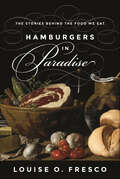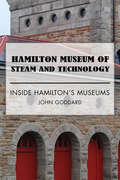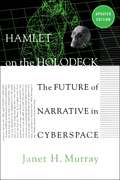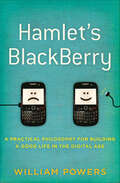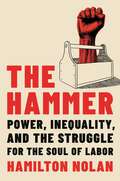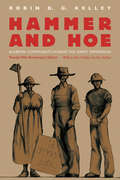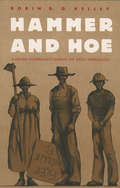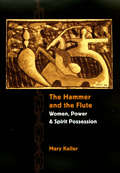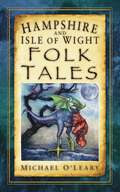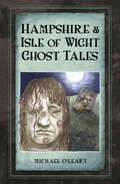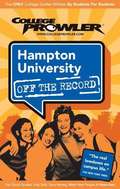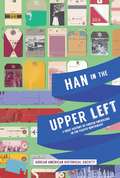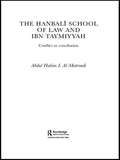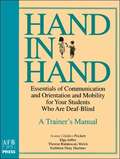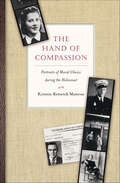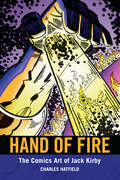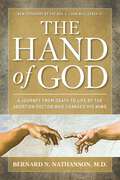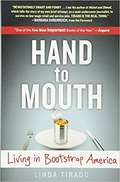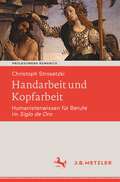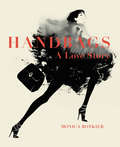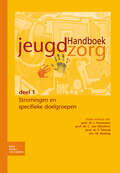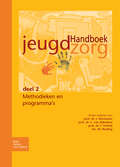- Table View
- List View
Hamburgers in Paradise: The Stories Behind the Food We Eat
by Louise O. FrescoA fascinating exploration of our past, present, and future relationship with foodFor the first time in human history, there is food in abundance throughout the world. More people than ever before are now freed of the struggle for daily survival, yet few of us are aware of how food lands on our plates. Behind every meal you eat, there is a story. Hamburgers in Paradise explains how.In this wise and passionate book, Louise Fresco takes readers on an enticing cultural journey to show how science has enabled us to overcome past scarcities—and why we have every reason to be optimistic about the future. Using hamburgers in the Garden of Eden as a metaphor for the confusion surrounding food today, she looks at everything from the dominance of supermarkets and the decrease of biodiversity to organic foods and GMOs. She casts doubt on many popular claims about sustainability, and takes issue with naïve rejections of globalization and the idealization of "true and honest" food. Fresco explores topics such as agriculture in human history, poverty and development, and surplus and obesity. She provides insightful discussions of basic foods such as bread, fish, and meat, and intertwines them with social topics like slow food and other gastronomy movements, the fear of technology and risk, food and climate change, the agricultural landscape, urban food systems, and food in art.The culmination of decades of research, Hamburgers in Paradise provides valuable insights into how our food is produced, how it is consumed, and how we can use the lessons of the past to design food systems to feed all humankind in the future.
Hamilton Museum of Steam and Technology: Inside Hamilton's Museums
by John GoddardInside Hamilton’s Museums helps to satisfy a growing curiosity about Canada’s steel capital as it evolves into a post-industrial city and cultural destination. In this special excerpt we visit Hamilton Museum of Steam and Technology, which displays the wondrous twin waterworks engines that supplied the City of Hamilton with fresh, safe drinking water. John Goddard takes us on a detailed tour of the dignified limestone building, providing fascinating historical background and insight into the waterworks.
Hamlet on the Holodeck
by Janet H. MurrayStories define how we think, the way we play, and the way we understand our lives. And just as Gutenberg made possible the stories that ushered in the Modem Era, so is the computer having a profound effect on the stories of the late 20th century. Today we are confronting the limits of books themselves -- anticipating the end of storytelling as we know it -- even as we witness the advent of a brave new world of cyberdramas. Computer technology of the late twentieth century is astonishing, thrilling, and strange, and no one is better qualified than Janet Murray to offer a breathtaking tour of how it is reshaping the stories we live by.Can we imagine a world in which Homer's Iyre and Gutenberg's press have given way to virtual reality environments like the Star Trek® holodeck? Murray sees the harbingers of such a world in the fiction of Borges and Calvino, movies like Groundhog Day, and the videogames and Web sites of the 1990s. Where is our map for this new frontier, and what can we hope to find in it? What will it be like to step into our own stories for the first time, to change our vantage point at will, to construct our own worlds or change the outcome of a compelling adventure, be it a murder mystery or a torrid romance? Taking up where Marshall McLuhan left off, Murray offers profound and provocative answers to these and other questions.She discusses the unique properties and pleasures of digital environments and connects them with the traditional satisfactions of narrative. She analyzes the state of "immersion," of participating in a text to such an extent that you literally get lost in a story and obliterate the outside world from your awareness. She dissects the titillating effect of cyber-narratives in which stories never climax and never end, because everything is morphable, and there are always infinite possibilities for the next scene. And she introduces us to enchanted landscapes populated by witty automated characters and inventive role-playing interactors, who together make up a new kind of commedia dell'arte. Equal parts daydream and how-to, Hamlet on the Holodeck is a brilliant blend of imagination and techno-wizardry that will provoke readers and guide writers for years to come.
Hamlet's BlackBerry: A Practical Philosophy for Building a Good Life in the Digital Age
by William PowersA crisp, passionately argued answer to the question that everyone who's grown dependent on digital devices is asking: "Where's the rest of my life?"At a time when we're all trying to make sense of our relentlessly connected lives, this revelatory book presents a bold new approach to the digital age. Part intellectual journey, part memoir, Hamlet's BlackBerry sets out to solve what William Powers calls the conundrum of connectedness. Our computers and mobile devices do wonderful things for us. But they also impose an enormous burden, making it harder for us to focus, do our best work, build strong relationships, and find the depth and fulfillment we crave.Hamlet's BlackBerry argues that we need a new way of thinking, an everyday philosophy for life with screens. To find it, Powers reaches into the past, uncovering a rich trove of ideas that have helped people manage and enjoy their connected lives for thousands of years. New technologies have always brought the mix of excitement and stress that we feel today. Drawing on some of history's most brilliant thinkers, from Plato to Shakespeare to Thoreau, he shows that digital connectedness serves us best when it's balanced by its opposite, disconnectedness. Using his own life as laboratory and object lesson, Powers demonstrates why this is the moment to revisit our relationship to screens and mobile technologies, and how profound the rewards of doing so can be. Lively, original, and entertaining, Hamlet's BlackBerry will challenge you to rethink your digital life.
The Hammer: Power, Inequality, and the Struggle for the Soul of Labor
by Hamilton NolanA timely, in-depth, and vital exploration of the American labor movement and its critical place in our society and politics today, from acclaimed labor reporter Hamilton Nolan. Inequality is America&’s biggest problem. Unions are the single strongest tool that working people have to fix it. Organized labor has been in decline for decades. Yet it sits today at a moment of enormous opportunity. In the wake of the pandemic, a highly visible wave of strikes and new organizing campaigns have driven the popularity of unions to historic highs. The simmering battle inside of the labor movement over how to tap into its revolutionary potential—or allow it to be squandered—will determine the economic and social course of American life for years to come. In chapters that span the country, Nolan shows readers the actual places where labor and politics meld. He highlights how organized labor can and does wield power effectively: a union that dominates Las Vegas and is trying to scale nationally; a successful decades-long campaign to organize California's child care workers; the human face of a surprising strike of factory workers trying to preserve their pathway to the middle class. Throughout, Nolan follows Sara Nelson, the fiery and charismatic head of the flight attendants&’ union, as she struggles with how (and whether) to assert herself as a national leader, to try to fix what is broken. The Hammer draws the line from forgotten workplaces in rural West Virginia to Washington&’s halls of power, and shows how labor solidarity can utterly transform American politics—if it can first transform itself. A labor journalist for more than a decade, Nolan helped unionize his own industry. The Hammer is a urgent on-the-ground excavation of the past, present, and future of the American labor movement.
Hammer and Hoe
by Robin D. KelleyA groundbreaking contribution to the history of the "long Civil Rights movement," Hammer and Hoe tells the story of how, during the 1930s and 40s, Communists took on Alabama's repressive, racist police state to fight for economic justice, civil and political rights, and racial equality. The Alabama Communist Party was made up of working people without a Euro-American radical political tradition: devoutly religious and semiliterate black laborers and sharecroppers, and a handful of whites, including unemployed industrial workers, housewives, youth, and renegade liberals. In this book, Robin D. G. Kelley reveals how the experiences and identities of these people from Alabama's farms, factories, mines, kitchens, and city streets shaped the Party's tactics and unique political culture. The result was a remarkably resilient movement forged in a racist world that had little tolerance for radicals.After discussing the book's origins and impact in a new preface written for this twenty-fifth-anniversary edition, Kelley reflects on what a militantly antiracist, radical movement in the heart of Dixie might teach contemporary social movements confronting rampant inequality, police violence, mass incarceration, and neoliberalism.
Hammer and Hoe
by Robin D. G. KelleyBetween 1929 and 1941, the Communist Party organized and led a radical, militantly antiracist movement in Alabama -- the center of Party activity in the Depression South. Hammer and Hoe documents the efforts of the Alabama Communist Party and its allies to secure racial, economic, and political reforms. Sensitive to the complexities of gender, race, culture and class without compromising the political narrative, Robin Kelley illustrates one of the most unique and least understood radical movements in American history.The Alabama Communist Party was built from scratch by working people who had no Euro-American radical political tradition. It was composed largely of poor blacks, most of whom were semiliterate and devoutly religious, but it also attracted a handful of whites, including unemployed industrial workers, iconoclastic youth, and renegade liberals. Kelley shows that the cultural identities of these people from Alabama's farms, factories, mines, kitchens, and city streets shaped the development of the Party. The result was a remarkably resilient movement forged in a racist world that had little tolerance for radicals.In the South race pervaded virtually every aspect of Communist activity. And because the Party's call for voting rights, racial equality, equal wages for women, and land for landless farmers represented a fundamental challenge to the society and economy of the South, it is not surprising that Party organizers faced a constant wave of violence.Kelley's analysis ranges broadly, examining such topics as the Party's challenge to black middle-class leadership; the social, ideological, and cultural roots of black working-class radicalism; Communist efforts to build alliances with Southern liberals; and the emergence of a left-wing, interracial youth movement. He closes with a discussion of the Alabama Communist Party's demise and its legacy for future civil rights activism.
The Hammer and the Flute: Women, Power, and Spirit Possession
by Mary KellerAward for the Best First Book in the History of Religions from the American Academy of ReligionFeminist theory and postcolonial theory share an interest in developing theoretical frameworks for describing and evaluating subjectivity comparatively, especially with regard to non-autonomous models of agency. As a historian of religions, Mary Keller uses the figure of the "possessed woman" to analyze a subject that is spoken-through rather than speaking and whose will is the will of the ancestor, deity or spirit that wields her to engage the question of agency in a culturally and historically comparative study that recognizes the prominent role possessed women play in their respective traditions. Drawing from the fields of anthropology and comparative psychology, Keller brings the figure of the possessed woman into the heart of contemporary argument as an exemplary model that challenges many Western and feminist assumptions regarding agency. Proposing a new theoretical framework that re-orients scholarship, Keller argues that the subject who is wielded or played, the hammer or the flute, exercises a paradoxical authority—"instrumental agency"—born of their radical receptivity: their power derives from the communities' assessment that they no longer exist as autonomous agents. For Keller, the possessed woman is at once "hammer" and "flute," paradoxically powerful because she has become an instrument of the overpowering will of an ancestor, deity, or spirit. Keller applies the concept of instrumental agency to case studies, providing a new interpretation of each. She begins with contemporary possessions in Malaysia, where women in manufacturing plants were seized by spirits seeking to resacralize the territory. She next looks to wartime Zimbabwe, where female spirit mediums, the Nehanda mhondoro, declared the ancestors' will to fight against colonialism. Finally she provides an imaginative rereading of the performative power of possession by interpreting two plays, Euripides' Bacchae and S. Y. Ansky's The Dybbuk, which feature possessed women as central characters. This book can serve as an excellent introduction to postcolonial and feminist theory for graduate students, while grounding its theory in the analysis of regionally and historically specific moments of time that will be of interest to specialists. It also provides an argument for the evaluation of religious lives and their struggles for meaning and power in the contemporary landscape of critical theory.
Hampshire and Isle of Wight Folk Tales (Folk Tales: United Kingdom)
by Michael O'LearyThese beautifully told folk tales, brought vividly to life by Marcel O’Leary’s graphic illustrations, have been collected by the author over his years of working as a greenkeeper, gardener, teacher and storyteller in Hampshire. Many are published here for the first time, and others have evolved through countless retellings in Hampshire schools, festivals, fêtes and events. Featuring dark tales of murderous kings and commoners, wild women, screaming skulls, galloping plague coaches, dragons dancing themselves to death, giants, and wandering corpses, combined with humorous stories and evocative tales of love, lust and passion, this book takes the reader beyond the written page and reveals the wonders that lie within the Hampshire landscape.
Hampshire and Isle of Wight Ghost Tales
by Michael O'Leary Ruth O'LearyThe stories in this haunting collection are as ancient and modern, powerful and fantastical, ambiguous and ambivalent as the ghosts they feature. Here you will find tales of headless horses riding moonbeams, an entrance to another world on Marrowbones Hill, drowned sailors and ghost ships, and a girl riding pillion on a motorbike driven by her dead boyfriend – all told in the distinct voice of noted storyteller Michael O’Leary who, for years, has wandered the highways and byways of Hampshire, immersed in the layers of ghost stories that have accumulated in this ancient county. Richly illustrated with original drawings, these tales are perfect for reading under the covers on dark, stormy nights.
Hampton University (College Prowler)
by Candace MeansFrom academics and diversity to nightlife and sports, this book let the students tell it how it is. In addition to editorial reviews and grades for 20 different topics, more than 80 percent of each guide is composed of actual student reviews of their school.
Han in the Upper Left: A Brief History of Korean Americans in the Pacific Northwest
by Korean American SocietyThis in-depth look at one of the fastest-growing immigrant groups in the Pacific Northwest provides a much-needed overview of the Korean American experience as well as moving personal anecdotes. Graphs offer information about Korean immigration patterns over time, while black-and-white portraits reveal the people behind the statistics.The Korean American Historical Society is a nonprofit organization founded in 1985 to enrich the collective memory of Korean Americans by collecting, maintaining, and transmitting their stories.
Han Material Culture
by Sophia-Karin PsarrasHan Material Culture is an analysis of Han dynasty (206 BC-AD 220) Chinese archaeology based on a comparison of the forms of vessels found in positively dated tombs. The resultant chronological framework allows for the cross dating of tombs across China, of which approximately one thousand are documented here. In the context of this body of data, the development of not only vessel types but also tomb structure and decor is reevaluated, together with the pervasive intercultural exchange visible in all areas of this material. The Han dynasty emerges as a creative, surprisingly open society, heir to the Bronze Age and herald of what might be called the Age of Ceramics.
The Hanbali School of Law and Ibn Taymiyyah: Conflict or Conciliation (Culture and Civilization in the Middle East)
by Abdul Hakim Al-MatroudiThe Hanbali School of Law and Ibn Taymiyyah provides a valuable account of the development of Hanbalite jurisprudence, placing the theoretical and conceptual parameters of this tradition within the grasp of the interested reader. Studying the vibrant yet controversial interaction between Ibn Taymiyyah and the Hanbali School of law, this book assesses to what extent this relationship was a conflict or reconciliation. The author takes a detailed exploration of the following issues: the strength of contributions made to this School by earlier paragons associated with Ahmad Ibn Hanbal the contextual constructs which shaped the tradition’s development the methodology and literature synonyms within the classical School the manner by which Ibn Taymiyyah engaged with the Hanbali tradition the impact of his thought upon the later expression of the School’s legal doctrines and its theoretical principles the contribution made by this School in general to the synthesis of Islamic law. Giving background material to the Hanbali School of law, this book is a vital reference work for those with interests in Islamic law, the history of the Hanbalite tradition and its principle luminaries.
Hand in Hand: Essentials of Communication and Orientation and Mobility for Your Students Who Are Deaf-Blind: Volume I, Units 1, 2, and 3
by Kathleen Mary Huebner Jeanne Glidden Prickett Therese Rafalowski Welch Elga JoffeeThis series was designed to develop resources for educators of children who are visually impaired, hearing impaired, and severely disabled. The Hand In Hand materials emphasize the communication and mobility skills crucial to independence, and provide important information to help service providers do their jobs effectively. Containing contributions from more than 30 nationally recognized experts in the field of deaf-blindness, this groundbreaking information consists of four components that can be used separately or together. A two-volume, self-study text that explains how deaf-blind students learn, focusing on essential communication and mobility skills. Designed to provide comprehensive information in an easy-to-read way, this invaluable resource includes identified key concepts, self-study questions and answers, and references. The user-friendly format includes concise "Help at a Glance" and "From Theory to Practice" sections throughout. Sidebars, figures, tables, graphs, and photos offer additional perspectives and information.
Hand in Hand: A Trainer's Manual
by Elga Joffee Jeanne Glidden Prickett Kathleen Mary Huebner Therese Rafalowski WelchAn in-service training guide that presents structured information and guidelines for using the Hand In Hand materials with various audiences. Focusing on the needs of the trainer, this manual provides sample blueprints for individual workshops, as well as an overview of training, assessment, and evaluation. Also includes sample forms for conducting a pre-training needs assessment and post training evaluation.
Hand in Hand: Essentials of Communication and Orientation and Mobility for Your Students Who Are Deaf-Blind: Volume II Appendixes, Glossary, Resources, Index
by Elga Joffee Jeanne Glidden Prickett Therese Rafalowski Welch Kathleen Mary HuebnerThis series was designed to develop resources for educators of children who are visually impaired, hearing impaired, and severely disabled. The Hand In Hand materials emphasize the communication and mobility skills crucial to independence, and provide important information to help service providers do their jobs effectively. Containing contributions from more than 30 nationally recognized experts in the field of deaf-blindness, this groundbreaking information consists of four components that can be used separately or together. A two-volume, self-study text that explains how deaf-blind students learn, focusing on essential communication and mobility skills. Designed to provide comprehensive information in an easy-to-read way, this invaluable resource includes identified key concepts, self-study questions and answers, and references. The user-friendly format includes concise "Help at a Glance" and "From Theory to Practice" sections throughout. Sidebars, figures, tables, graphs, and photos offer additional perspectives and information.
The Hand of Compassion: Portraits of Moral Choice during the Holocaust
by Kristen Renwick MonroeThrough moving interviews with five ordinary people who rescued Jews during the Holocaust, Kristen Monroe casts new light on a question at the heart of ethics: Why do people risk their lives for strangers and what drives such moral choice? Monroe's analysis points not to traditional explanations--such as religion or reason--but to identity. The rescuers' perceptions of themselves in relation to others made their extraordinary acts spontaneous and left the rescuers no choice but to act. To turn away Jews was, for them, literally unimaginable. In the words of one German Czech rescuer, "The hand of compassion was faster than the calculus of reason." At the heart of this unusual book are interviews with the rescuers, complex human beings from all parts of the Third Reich and all walks of life: Margot, a wealthy German who saved Jews while in exile in Holland; Otto, a German living in Prague who saved more than 100 Jews and provides surprising information about the plot to kill Hitler; John, a Dutchman on the Gestapo's "Most Wanted List"; Irene, a Polish student who hid eighteen Jews in the home of the German major for whom she was keeping house; and Knud, a Danish wartime policeman who took part in the extraordinary rescue of 85 percent of his country's Jews. We listen as the rescuers themselves tell the stories of their lives and their efforts to save Jews. Monroe's analysis of these stories draws on philosophy, ethics, and political psychology to suggest why and how identity constrains our choices, both cognitively and ethically. Her work offers a powerful counterpoint to conventional arguments about rational choice and a valuable addition to the literature on ethics and moral psychology. It is a dramatic illumination of the power of identity to shape our most basic political acts, including our treatment of others. But always Monroe returns us to the rescuers, to their strong voices, reminding us that the Holocaust need not have happened and revealing the minds of the ethically exemplary as they negotiated the moral quicksand that was the Holocaust.
Hand of Fire: The Comics Art of Jack Kirby (Great Comics Artists Series)
by Charles HatfieldJack Kirby (1917–1994) is one of the most influential and popular artists in comics history. With Stan Lee, he created the Fantastic Four and defined the drawing and narrative style of Marvel Comics from the 1960s to the present day. Kirby is credited with creating or cocreating a number of Marvel's mainstay properties, among them the X-Men, the Hulk, Thor, and the Silver Surfer. His earlier work with Joe Simon led to the creation of Captain America, the popular kid gang and romance comic genres, and one of the most successful comics studios of the 1940s and 1950s. Kirby's distinctive narrative drawing, use of bold abstraction, and creation of angst-ridden and morally flawed heroes mark him as one of the most influential mainstream creators in comics. In this book, Charles Hatfield examines the artistic legacy of one of America's true comic book giants. He analyzes the development of Kirby's cartooning technique, his use of dynamic composition, the recurring themes and moral ambiguities in his work, his eventual split from Lee, and his later work as a solo artist. Against the backdrop of Kirby's earlier work in various genres, Hand of Fire examines the peak of Kirby's career, when he introduced a new sense of scope and sublimity to comic book fantasy.
Hand of God: A Journey from Death to Life by The Abortion Doctor Who Changed His Mind
by Bernard NathansonHe presided over 61,000 abortions-one of which was suffered by his then-girlfriend-and directed the largest abortion clinic in the world. He had helped to legalize abortion in the first place. <P><P>One day, he had a change of heart. One day, he found God. <P><P>At the drop of a hat, an abortion doctor renounced his profession-and his atheism-for pro-life advocacy and Christianity. <P><P>In the most shocking revelations ever expressed in an autobiography, one man unveils his entire life story, detailing countless events-from his gruesome abortion procedures to his conversion and involvement in The Silent Scream. <P><P>Discover one man's incredible journey from death to life in Bernard Nathanson's The Hand of God.Now in paperback, this book features and introduction by Reverend C.J. McCloskey, III.
Hand to Mouth
by Linda Tirado"I've been waiting for this book for a long time. Well, not this book, because I never imagined that the book I was waiting for would be so devastatingly smart and funny, so consistently entertaining and unflinchingly on target. In fact, I would like to have written it myself - if, that is, I had lived Linda Tirado's life and extracted all the hard lessons she has learned. I am the author of Nickel and Dimed, which tells the story of my own brief attempt, as a semi-undercover journalist, to survive on low-wage retail and service jobs. Tirado is the real thing." --from the foreword by Barbara Ehrenreich, New York Times bestselling author of Nickel and Dimed We in America have certain ideas of what it means to be poor. Linda Tirado, in her signature brutally honest yet personable voice, takes all of these preconceived notions and smashes them to bits. She articulates not only what it is to be working poor in America (yes, you can be poor and live in a house and have a job, even two), but what poverty is truly like--on all levels. In her thought-provoking voice, Tirado discusses how she went from lower-middle class, to sometimes middle class, to poor and everything in between, and in doing so reveals why "poor people don't always behave the way middle-class America thinks they should."
Handarbeit und Kopfarbeit: Humanistenwissen für Berufe im Siglo de Oro (Prolegomena Romanica. Beiträge zu den romanischen Kulturen und Literaturen)
by Christoph StrosetzkiIn der frühen Neuzeit beschäftigen sich zahlreiche Texte mit Berufen, indem sie das jeweils erforderliche Wissen, einzelne Aufgabenfelder, Zweck, Ursprung und Prestige darstellen. Humanistisch ist der Argumentationsgang, insofern er meist vom Menschen ausgeht. Prägend ist dabei die antike Vorstellung vom Vorrang der Kopfarbeit vor der Handarbeit. Die Bedeutung Spaniens ergibt sich daraus, dass der spanische König Karl V. zugleich Kaiser und Herrscher über die Kolonien in Amerika war, also nach damaligen Verhältnissen ein Weltreich regierte. Nach der Erörterung einiger zentraler Kategorien werden Gesamtdarstellungen des Wissens, der Berufe und der herausragenden Berufsvertreter vorgestellt. Dabei ist die Hierarchisierung und deren Relativierung durch die Satire aufschlussreich. Anhand einzelner als charakteristische Beispiele ausgewählter Berufe mit jeweiligem spezifischen Wissen werden dann die mechanischen Künste und die artes liberales vorgeführt. Den Abschluss bilden die höheren Fakultäten Medizin, Theologie und Jurisprudenz mit ihren Vertretern.
Handbags: A Love Story
by Monica BotkierIn this sumptuous full-color compendium, award-winning designer Monica Botkier celebrates seventy of the most coveted bags of the past seventy-five years, from Chanel, Dior, Gucci, Hermès, Yves Saint Laurent, Louis Vuitton, and other international couture houses, as well as top bag designers such as Anya Hindmarch and Nancy Gonzalez.Exquisitely crafted luxury handbags are an obsession. The look, the feel of soft leather, that new bag smell that induces a swoon—a gorgeous handbag does more than complete a look, it telegraphs taste and chic, and it inspires envy, whether it’s an Hermès Birkin, a quilted Chanel Boy bag with its signature gold chain, or a Céline Mini Luggage Tote. Award-winning handbag designer Monica Botkier pays homage to these gorgeous objects of desire and the top couture houses and artists that have designed and produced them from the end of World War II to today.Handbags: A Love Story showcases the creations of designers such as Azzedine Alaïa, Balenciaga, Bottega Veneta, Céline, Chanel, Chloé, Christian Dior, Mark Cross, Fendi, Salvatore Ferragamo, Givenchy, Goyard, Gucci, Hermès, Anya Hindmarch, Judith Leiber, Olympia Le-Tan, Loewe, Mansur Gavriel, Stella McCartney, Alexander McQueen, Miu Miu, Moschino, Mulberry, Prada, Yves Saint Laurent, Valentino, Roger Vivier, Louis Vuitton, and more. This magnificent, eye-catching anthology tells the story of seventy bags in 200 stunning photographs and vintage and contemporary advertisements and illustrations, as well as quotes, anecdotes, and interviews with designers, stylists, and editors.Each entry offers a concise yet in-depth look at a specific bag and its history—from a celebrity muse, such as Jane Birkin, to collaborations such as the graffiti-splattered bags Marc Jacobs and Stephen Sprouse created for Louis Vuitton. An informative, entertaining exploration of how "It Bags" have influenced fashion, culture, and feminine identity, Handbags: A Love Story touches on a wide-range of subjects, such as how a bag is constructed and handbags on the silver screen.With an elegant full-color silkscreened cloth case and a thick acetate four-color jacket; two long, wide satin markers, and two-color endpapers, this gorgeous tribute is an essential accessory for handbag fanatics, fashion lovers, and pop culture enthusiasts.
Handboek jeugdzorg deel 1: Stromingen en specifieke doelgroepen
by J.M.A. Hermanns F. Verheij C.H.C.J. van Nijnatten M.A.W.L. ReulingHandboek jeugdzorg (in twee delen) biedt een gedegen overzicht van alle relevante aspecten van de jeugdzorg: achtergronden, doelgroepen en de dagelijkse praktijk. Gekozen is voor een breed werkveld – breder dan de hulp die in het kader van de Wet op de Jeugdzorg wordt geboden – ook jeugdbeschermingsmaatregelen, de geestelijke gezondheidszorg en het preventieve en opvoedingsondersteunende aanbod komen in dit handboek aan de orde. Ieder hoofdstuk is geschreven door een auteur die op dat terrein gezaghebbend is.Dit deel (deel 1) 'Stromingen en specifieke doelgroepen' gaat over de achtergronden en doelgroepen in de jeugdzorg. Onderdeel A schetst de historische achtergrond van de jeugdzorg. Inzicht in de huidige ontwikkelingen is namelijk alleen goed mogelijk als ze geplaatst worden in een historisch kader. Onderdeel B behandelt de verschillende theoretische stromingen die ten grondslag liggen aan de jeugdzorg. Onderdeel C ten slotte beschrijft vijftien specifieke doelgroepen, diein het werkveld aan een aparte benadering onderworpen worden.Deel 2 gaat over de dagelijkse uitvoeringspraktijk van de jeugdzorg. Methodieken en zorgprogramma"s staan hierin centraal.
Handboek jeugdzorg deel 2: Methodieken en programma's
by J.M.A. Hermanns F. Verheij C.H.C.J. van Nijnatten M.A.W.L. ReulingHandboek jeugdzorg (in twee delen) biedt een gedegen overzicht van alle relevante aspecten van de jeugdzorg: achtergronden, doelgroepen en de dagelijkse praktijk. Gekozen is voor een breed werkveld – breder dan de hulp die in het kader van de Wet op de Jeugdzorg wordt geboden – ook jeugdbeschermingsmaatregelen, de geestelijke gezondheidszorg en het preventieve en opvoedingsondersteunende aanbod komen in dit handboek aan de orde. Ieder hoofdstuk is geschreven door een auteur die op dat terrein gezaghebbend is.Dit deel (deel 2) van Handboek jeugdzorg gaat over de dagelijkse uitvoeringspraktijk van de jeugdzorg. Methodieken en zorgprogramma's staan hierin centraal. Onderdeel A belicht de preventie; onderdeel B gaat over zorg en gezag. Alle hoofdstukken van onderdeel C hebben betrekking op zorgprogramma"s voor kinderen of jongeren die (deels) niet meer thuis verblijven. Onderdeel D bespreekt methodieken en programma"s waarbij het accent ligt op de begeleiding in het dagelijks leven. Deel 2 wordt afgesloten met onderdeel E, dat gaat over therapeutische methodieken die vaak in de jeugdzorg worden toegepast.Deel 1 behandelt de achtergronden en doelgroepen in de jeugdzorg.
